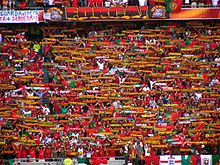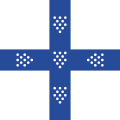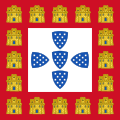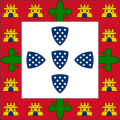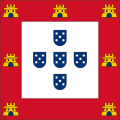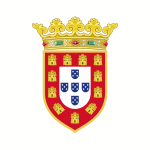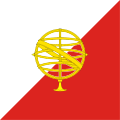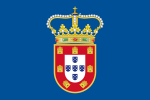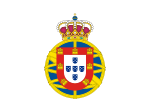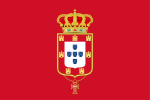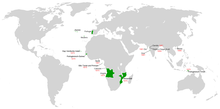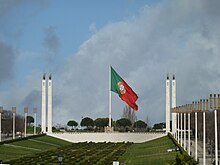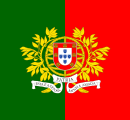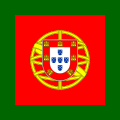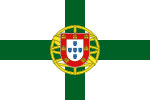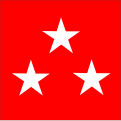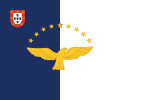Flag of Portugal
| Flag of Portugal | |
|---|---|
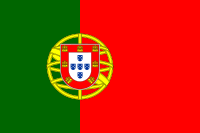 |
|
| Vexillological symbol : |
|
| Aspect ratio: | 2: 3 |
| Officially accepted: | June 30, 1911 |
In the eventful history of the country, the flag of Portugal evolved from the royal coat of arms banners to the symbol of republican Portugal , which was adopted in 1911. It was repeatedly adapted to contemporary tastes or political changes, but was never completely replaced by a new design. The individual elements of today's flag therefore come from the different epochs of the history of Portugal . The last change, the change of the background colors from blue-white to green-red, led to political disputes in Portugal. Riots broke out in the colony of Portuguese Timor , where the flag in its old design was revered as sacred.
In addition to the national flag, there are a large number of flags for state organs and administrative units, the appearance of which is regulated by law. Parts and symbols from the national flag and its predecessors can be found here again and again.
Structure, colors and meaning
Heraldically, the flag is split into green and red in a ratio of 2: 3. In the decree of 1911 the flag is described as follows: bi-partida verticalmente em duas côres fundamentaes, verde escuro e escarlate, ficando o verde do lado da tralha (“vertically divided into two basic colors, dark green and scarlet red, with the green side am Mast").
Originally, these were the colors of the republican movement, which they adopted from the radical republican secret society Carbonária , which was one of the roots of the 1910 revolution. The members called themselves Köhler , after the older Italian model of the Carbonari . The charcoal burners could go from the cities into the forests without restriction, where the society held conspiratorial meetings, hence their second name: The Forest Freemasons (Maçonaria Florestal) . Johannes , the patron saint of charcoal burners, was assigned the colors red and green, which is why the real charcoal burners and later the secret society used these colors.
Although there were Portuguese flags with this color combination before, they did not serve as a model for today's national flag. There are different explanations for the meaning of the colors. According to the most common from the time of the Estado Novo , the green color stands for hope and the red color for the blood of those who gave their lives for the nation. According to another interpretation, the green color is supposed to represent the conquered colonies , while the red color element symbolizes the blood spilled in battle.
The exact web colors of the flag are officially regulated:
| red | green | yellow | blue | White | black |
| # F00 | # 060 | # FF0 | # 039 | #FFF | # 000 |

The flag is covered on the gap with an armillary sphere (a navigation device in the form of a stylized globe) made of five narrow golden bands, which denote the equator , the tropics of Cancer and Capricorn and a meridian , as well as a band twice as wide from the left top to bottom right, which denotes the ecliptic or the annual solar revolution. The armillary sphere, a personal emblem of King Manuel I (1495–1521), is a symbol of the Age of Discovery and is half the diameter of the flag.
The armillary sphere is covered with a white bordered red shield with seven golden Castilian castles, inside which in turn covered with a white shield with five blue shields in cross shape, each with five white coins 2: 1: 2. The coat of arms has been part of the flag in various variations since 1495. Before that, the coat of arms was converted into a coat of arms banner for the flag. The shield has a width which corresponds to a fifth of the flag length and a height of 7/30 of the flag length. Armillary sphere and heraldic shield together form the coat of arms of Portugal .
Since the national flag is relatively complicated by the coat of arms, there are always simplistic and incorrect representations. Most often, small pictograms simply show a green-red flag without a coat of arms or with a yellow disc. Larger images sometimes leave out the armillary sphere, although it is an integral part of the coat of arms. Another common mistake is the use of towers instead of castles in the coat of arms.
history
There are no contemporary sources about the flags of the founding time of Portugal in the 12th century. Most of the reports are 200 years younger. Reports of the flags of Portugal around 1400 also only date from the 16th century. The source here is the national epic of Portugal, the Lusiads .
1095 to 1248
The first known symbol of Portugal was the coat of arms of Henry of Burgundy , who from 1096/97 was the second Count of Portugal and progenitor of the first Portuguese royal house . According to the sources, Heinrich wore a shield with a simple blue cross on a silver background in the fight against the Moors in 1095.
Heinrich's son declared the independence of the Kingdom of Portugal from its liege lords Castile after the battle of Ourique against the Moors in 1139 and was crowned the first king of Portugal as Alfonso I. In 1143 the independence of Castile was recognized in the Treaty of Zamora . Up to this point Alfons wore the same shield as his father Heinrich. According to a source from 1908, after his recognition as king, Alfonso added eleven silver coins ( besantes or dinheiros ) to the cross five times as a sign of his new status . They are supposed to symbolize the king's right to coin .
At the time, it was common practice to repair the combat damage on shields rather than making new ones. Hence, changes in heraldry such as color changes, loss of parts of symbols, or alterations were not uncommon. The shield of Alfonso I is said to have been badly damaged when his son Sancho I inherited it. The blue leather of the cross was only held in place by the silver nails that symbolized the coins. This supposedly led to the leather being cut into small blue shields (the five quina ) with eleven coins each in the center. The point of three of the four outer shields pointed towards the center of the cross. The importance of the battle of Alfonso I near Ourique , in which he defeated the five Moorish kings of the Taifa empires of Seville , Badajoz , Elvas , Évora and Beja , and took away their shields. Sancho's son Alfonso II and grandson Sancho II kept the coat of arms. Even today, the five quinas form the center of the Portuguese coat of arms.
1248 to 1495
Alfons III was the younger brother of his predecessor Sancho II and not his son. Therefore, according to the heraldic rules of the time, he could not take over the coat of arms of his predecessors without making changes. It is believed that he included Castilian castles in a red frame around the old coat of arms because his mother Urraca and his wife Beatrix both came from Castile. The number of coins on the quinas varied between seven, eleven and sixteen. Alfons III used sixteen coins. as Count of Boulogne . The number of castles was not specified either.
After the extinction of the Burgundian house in 1383, Johann, the Grand Master defended the Equestrian Order of Avis , 1385 in the Battle of Aljubarrota Castilian claims on Portuguese throne and became as John I of Portugal's first king of the house Avis . Johann included the green lily cross of his knightly order in his banner, the ends of which now appeared on the red border and reduced the number of castles to twelve. There were now seven coins in each quina, other sources give eleven coins per quina.
It was not until Johann's grandson Johann II introduced the coat of arms in the form it is used today for the first time 100 years later. The Avis cross was removed from the coat of arms, the number of coins set at five per quina, the quinas all turned with the point downwards and their points rounded. Today the five coins are said to represent the five wounds of Christ . If you count the coins in the shields crosswise and count the coins in the middle shield twice, you get 30 coins. These represent the 30 silver coins that Judas received for betraying Jesus Christ. The number of castles was set at seven. In the modern interpretation they symbolize the seven battles that King Alfons III. won during the conquest of the Algarve and thus the final expulsion of the Moors from what is now Portugal.
1495 to 1667
King Manuel I was the first to use a flag with an aspect ratio of 2: 3 instead of a square heraldic banner, which did not represent the king but the empire. The coat of arms of Portugal with eleven castles and the royal crown was on a white background. On his personal standard, Manuel I, under whose reign the sea route to India was discovered, showed the armillary sphere for the first time.
Manuel I was already Grand Master of the Order of Christ before his accession to the throne in 1495 . This is why he originally used a square flag with the cross of the Order of Christ on a green background at sea, and later also on land.
In 1578 the flag was changed under King Sebastian I on the eve of the Battle of Alcácer-Quibir . The number of castles was finally set at seven and the crown was given three stirrups. Sebastian I. fell in battle. His great uncle Heinrich I succeeded him to the royal throne. With Henry's death in 1580, the Portuguese dynasty of Avis died out and Portugal fell to the King of Spain . Since Portugal and Spain were led by him in a personal union, the flag of Portugal was still valid for the country. The coat of arms of Portugal was included in the banner of the Habsburg king.
In 1640 the Spanish rule was shaken off, and with John IV the House of Bragança now ascended the throne. The coat of arms on the flag was rounded off to the so-called Spanish form . As the king's flag, Johann carried the coat of arms on a blue field. The green flag with the cross of the Order of Christ by Manuel I experienced a renaissance as an unofficial, but more popular flag.

 ? Flag of Portugal from 1495
? Flag of Portugal from 1495

 ? Alternative personal standard Manuel I.
? Alternative personal standard Manuel I.

 ? Alternative national flag under Manuel I and unofficial flag in the time of the Restoration in 1640
? Alternative national flag under Manuel I and unofficial flag in the time of the Restoration in 1640

 ? Flag of Portugal from 1578
? Flag of Portugal from 1578

 ? Flag of Portugal from 1640
? Flag of Portugal from 1640
1667 to 1830
Under Peter II , the previous coat of arms crown was replaced by a crown with five ribbons. The royal flag now has a green background. His son Johann V changed the crown and shape of the coat of arms again in 1706 (now the Modern French Form ) and chose a red color as the background of the royal flag. Red remained the color of the Portuguese kings until the end of the monarchy.
In 1807 the Portuguese royal court fled from Napoleon's troops to Rio de Janeiro , which became the new seat of government of the empire. In 1815 Brazil received the status of its own kingdom, which was in personal union with Portugal by John VI. was ruled. In 1816, Johann VI. hence the flags of the kingdoms of Portugal and Brazil: He added the armillary sphere from the Brazilian flag to the Portuguese one. In addition, the coat of arms was rounded off again. The royal flag of Portugal remained unchanged. When Brazil was given the status of a colony again, the Portuguese Crown Prince as was Peter I the emperor of Brazil crowned and declared the country's independence in 1822, which Portugal lost its largest and richest colony final.

 ? Flag of the United Kingdom of Portugal, Brazil and the Algarve 1816 to 1822
? Flag of the United Kingdom of Portugal, Brazil and the Algarve 1816 to 1822

 ? Flag of the Kingdom of Brazil 1816 to 1822
? Flag of the Kingdom of Brazil 1816 to 1822
1830 until today
After the separation of Portugal and Brazil in 1822, the kings of Portugal continued to fly the Union flag. During the War of Miguelists , the Liberals founded a government in exile in the Azores . It used a blue and white flag with the state coat of arms in modern French form and a crown in the center. When King Michaels I went into exile in 1834, the blue and white flag became the new flag of Portugal. At sea the blue part only took up a third of the flag, while on land the two parts of the flag were the same size. Peter V (1853–1861) changed the king's flag again and added the cross of the Order of Christ to the coat of arms below.
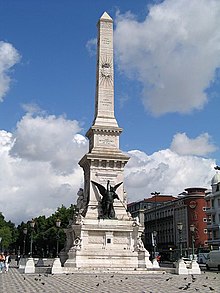
With the proclamation of the republic on October 5, 1910 , such a violent dispute broke out over the future symbols of the country that it was later referred to as the “ flag war ” (A Guerra das Bandeiras) . During this time there were a multitude of different proposals for a new national flag. The primary colors were discussed. While the Republicans wanted red and green as the new colors, the monarchists clung to the old blue and white. Blue also had a religious meaning as the color of Our Lady of Conception (Nossa Senhora da Conceição) , the patron saint of Portugal. This was a thorn in the eyes of the Republicans who sought the secularization of Portugal. From October 15, 1910, various drafts were discussed in a government commission. Members were the journalist and politician João Chagas , the painter Columbano Bordalo Pinheiro , the writer Abel Botelho and two military leaders of the revolution: Ladislau Pereira and Afonso Palla . In the end, the commission opted for the Republican Party's green and red . The political meaning of these colors, already used by the republican insurgents on January 31, 1891 in Porto , was hidden behind patriotic reasons.
The new flag was produced in large numbers in the Cordoaria Nacional ("National Ship Stowage House ") and officially presented throughout the country on the anniversary of the restoration of independence on December 1, 1910. The day was proclaimed “Flag Day” by the government, but it is no longer celebrated today. In the capital, Lisbon, the new flag was brought to the Monumento Restauradores and set there for the first time.
The decree, which exchanged the blue and white flag of the monarchy for the green and red flag of the republic, was passed by the constituent assembly and published in Diário do Governo No. 141 on June 19, 1911. On June 30, 1911, the regulations were officially published in Diário do Governo No. 150.
By the Carnation Revolution in 1974, the green and red flag had established itself as a real national flag to such an extent that the change from dictatorship back to democracy did not lead to discussions about a new flag, although the flag, like the coat of arms and its components, was extensively derived from the Estado Novo were used. The green and red flag continued to be associated with the 1910 republic rather than the Salazar dictatorship . The colors of the flag are used today as the national colors of Portugal and can be found in this way again and again in everyday life, such as at sporting events.
More historical flags
Flags of the Estado Novo
During the fascist dictatorship in Portugal, the Estado Novo between the 1930s and 1974, there were several political organizations with their own flags. The União Nacional ( National Union ) was the only legal party during the dictatorship, but officially it was not a party, but an "organization of the unity of all Portuguese". It showed the five quinas and a blue frame on a square flag. The Legião Portuguesa (" Portuguese Legion ") was a paramilitary state organization. It used a square flag with the green cross of the Order of Avis on a white background with a green frame. The Mocidade Portuguesa (" Portuguese Youth ") was the national youth organization. It used a flag similar to that of John I with the coat of arms of Portugal as a basis and the Avis cross. The only difference: The Quinas only carried five coins each, as is common in modern coats of arms, and their shape was changed to a pentagon. In the version of the youth organization for girls, the square was turned on top.
1: 1 ? União Nacional

1: 1 ? Legião Portuguesa

1: 1 ? Mocidade Portuguesa

1: 1 ? Mocidade Portuguesa Feminina

Flags of the colonies
As a rule, the colonies of Portugal did not have their own flags. Mostly only the national flag of Portugal was used.
In the colony of Portuguese Timor , the flag had a special meaning for colonial rule. The Liurais , the traditional rulers of Timor , drew part of their claim to power from sacred objects ( lulik ) that were owned by the ruling families. When the Portuguese subjugated the Timorese, they gave the Liurais as vassals the Portuguese flag, which in the eyes of the Timorese, just like the flagpole, became sacred objects that legitimized the rule of the Portuguese and the Liurais who were loyal to them. In the Mambai culture in particular , the cult of the flag was of central importance. According to their original myth, the world order is created by two brothers. The elder brother, from whom the peoples of Timor are descended, has ritual power over the cosmos. The younger brother has power over the social order. The non-Timorese peoples descend from this, in this case the Portuguese. The myth tells of the loss, search and recovery of a lost, sacred object, namely the Portuguese flag. This sacred meaning of the blue and white flag created some problems when the flag of Portugal was changed to the green and red in 1910 when it switched from monarchy to republic. The new flag was often not adopted and the old flag of the monarchy was still used by the Liurais.
A special feature were the flags of the government and parliament of Macau , the Loyal Senate (Leal Senado) : Both were light blue. The flag of the government showed the great coat of arms of Macau from 1935. The banner under the coat of arms originally read "Portuguese Colony of Macau" (Colónia Portuguesa de Macau) , from 1951 "Portuguese Province of Macau" (Provín. Portuguesa de Macau) and from 1975 until the handover of Macau to the People's Republic of China in 1999 "Government of Macau" (Governo de Macau) . Such a flag is not known from the governments of other colonies in Portugal. The flag of the Leal Senado carried the Portuguese heraldic shield with two angels as shield holders and above a cross of the Knights of Christ, a golden crown and a golden armillary sphere. Underneath a banner with the inscription “City of the name of the Lord of Macau, no other was more faithful” (Cidade do Nome de Deus de Macau nicht há outra mais leal) . The Senate was given the nickname Loyal because it refused to recognize the Kingdom of Spain, with which Portugal was linked from 1580 to 1640, as the new leading power in Macau. For this reason, the Portuguese flag, instead of the Spanish flag, flew over Macau during this time. The flag of the Leal Senado was often used as the unofficial flag of Macau , but officially it was the national flag of Portugal.
The flags of the colonial cities, which were based on the municipal flags of Portugal, were quite common. For example the flag of Dili , the capital of Portuguese Timor (East Timor). The eightfold green and white flag showed the city's coat of arms in the center, adorned with a brick crown. The golden color of the crown indicated Dili's status as the capital of a Portuguese overseas province . The five towers indicated that Dili was a cidade with more than 10,000 inhabitants. Below the coat of arms was a banner with the official name of the city, Cidade de Díli .
According to a source from 1939, the various official officials for the overseas provinces of Portugal carried flags with a uniform basic design that is still found in members of the government today: flags with a white base and the national coat of arms in the center. In addition to the colonial high commissioner, the colonial officials also had the national coat of arms on a cross of the Knights of Christ.
2: 3 ? Colonial High Commissioner

2: 3 ? Governor General of the Colony

2: 3 ? Governor of the colony

The Portuguese heraldist FP de Almeida Langhans proposed in 1967 to add the respective coats of arms in the lower right quarter of the national flag for the colonies of Portugal . However, this proposal was never implemented.
 ? Macau
? Macau
 ? Portuguese Timor
? Portuguese Timor
 ? Portuguese East Africa (Mozambique)
? Portuguese East Africa (Mozambique)
 ? Portuguese West Africa (Angola)
? Portuguese West Africa (Angola)
Flag protocol
legislation

Article 11 of the Portuguese Constitution only provides:
"The national flag (Bandeira Nacional), symbol of the sovereignty of the Republic and Portugal's independence, unity and integrity, is that adopted by the Republic, which was proclaimed on October 5, 1910."
On March 30, 1987, Ordinance No. 150 was amended. According to this, the flag should be set on Sundays and national holidays across the country between nine in the morning and sunset. The flag must be sufficiently illuminated at night. The flag can also be hoisted at the venue on days when official ceremonies or solemn public gatherings take place. On other days the flag can be flown if the central government, regional or local authorities or the leadership of private institutions deem it appropriate. The flag must match the official design and be in good condition. The national flag can be set daily on the main buildings of public corporations, civil and military national monuments. The same applies to public administration buildings and headquarters of public companies and institutions. Citizens and private institutions are also allowed to fly the flag, provided they observe the legal requirements and treat the flag with respect. The regulation does not provide for a penalty for disregarding these rules. In the case of international organizations in Portugal, the flag of the flag protocols valid there is set.
If other flags are placed next to the national flag, the national flag must not be smaller than the other flag and must be placed in the honorary position. In the case of two flagpoles , this is the right-hand mast from the perspective of a person looking at the outside of a building. With three, this is the middle mast. If there are more than three masts within a building and an odd number, the middle mast, if there is an even number, the mast to the right of the center. Outside the building it is always the mast at the right end of the row. If the masts are of different heights, the national flag must be set at the highest point. The masts must generally stand or be fixed in prominent positions, be it on the ground, on facades or on roofs. The flag may not be used purely for decoration, for concealment, or for uses that degrade it.
If national mourning is scheduled, the flag is raised at half-mast on the specified number of days . Every flag that is hoisted together with the national flag must then also be raised at half-mast.
Fold the national flag
If you want to fold the national flag correctly, you need four people to hold it by the sides. The goal is a package in which only the coat of arms is visible above. First the upper third of the flag is folded over so that the upper edge of the coat of arms is on the outer edge. The same is done with the lower third. Next, fold the remaining red part down to the edge of the coat of arms. Since the remaining green piece is longer than the coat of arms, it is tucked in so that it disappears completely under the coat of arms.

|
|
|
|
| Step 1 | 2nd step | 3rd step | 4th step |
More flags of Portugal
Government flags
The flag of the President of Portugal consists of the coat of arms with the golden armillary sphere on a green background. It blows at the President's seat in the Palácio Nacional de Belém and at the President's car. The same symbols can be found on the flags of the ministers. A green St. Andrew's cross on a white background serves as the background . The Prime Minister's flag also has a red border with gold laurel leaves. The flag of the now defunct Minister of War was a green and red two-part flag with five white stars. The Portuguese parliament leads since January 3, 2007 coat of arms and armillary sphere on a flag with green border and white background.
Military flags

Portugal's armed forces fly their own flag on land, which was adopted in 1911. It has an aspect ratio of 12:13 and the background is 1: 1 vertically divided into green and red halves. In the middle is the large version of the coat of arms of Portugal: the coat of arms shield with the armillary sphere, golden laurel branches and a banner with "Esta é a ditosa pátria minha amada" ("This is my beloved, happy fatherland"). It is a verse by Luís de Camões , Portugal's national poet.
The current Gösch ( jaco or jaque ) of the Portuguese Navy has also existed since 1911 , a square flag with a green border (1/8 of the flag width) and the small national coat of arms (coat of arms with armillary sphere) in the center on a red background. The armillary sphere has a diameter of 3/7 the width of the flag. It is set between sunrise and sunset at the bow of ships that are anchored or moored in port. The national flag flies at the stern between sunrise and sunset when the ship is anchored or in port and 24 hours a day when the ship is sailing.
In addition, the Portuguese Navy has different rank flags, all of which show a green cross on a white background. When there was still a naval minister, he carried the national coat of arms with a shield and armillary sphere in the center. This flag may be used by the Minister of Defense today. The commander-in-chief of the fleet carries a cross of the Order of the Knights of Christ in the upper left field, the admiral of the fleet carries the national coat of arms with heraldic shield and armillary sphere and an admiral only the cross. A vice admiral shows a red disk in the upper left field, a rear admiral a second in the lower left field. The additional symbols in the admiral flags are shifted to the left in the fields.
The army and air force have their own flags. The army has a red flag with a golden lion and sword. The air force has a medium blue flag with a golden, red armored eagle in the upper left corner with a banner with the Latin motto "Ex moro motu".
 ? 12:13, flag of the Portuguese Armed Forces
? 12:13, flag of the Portuguese Armed Forces
 ? Flag of the Minister of the Navy
? Flag of the Minister of the Navy
Subnational flags of Portugal
With the Azores and Madeira, Portugal has two archipelagos in the Atlantic that are administered as autonomous regions.
Main articles: Flag of the Azores and Flag of Madeira
Continental Portugal is divided into five regions, 18 districts (at least some of which have flags) and 308 Municípios ("municipality") with more than 4000 freguesias ("municipalities"). The municípios and freguesias have their own flags. The appearance of the flag is basically dependent on the size of the population. There are three orders of magnitude:
- Cidade : A city with at least ten thousand inhabitants.
- Vila : a small town with a few thousand inhabitants.
- Aldeia : A village with up to a few hundred inhabitants.
The town's coat of arms is usually located in the center of each flag, but it can also be omitted for simplicity. A silver brick crown with three (Aldeia), four (Vila) or five (Cidade) towers is also placed on the coat of arms. Lisbon as the capital wears a golden crown. Below the coat of arms there is also a banner with the name of the administrative unit. According to the Municipal Flag Act, Cidades have eight- fold flags , Vilas quartered and Aldeias single-colored flags. In addition, the law states that according to the heraldic rules, color can only follow metal (silver or gold), and metal can only follow color. However, there are always exceptions, for example Fronteira has a single color instead of a quartered flag, Lagos ' flag is quartered instead of eight. In addition, only the flag of Lagos is quartered diagonally. This is supposed to be a reference to the personal standard of King Manuel I, under whose reign Lagos benefited from the exploration of the new sea routes. The color rule is not always adhered to, for example with the flag of Maia , in which the heraldic color red follows the heraldic color blue. The municipality of Horta in the Azores uses a gold crown instead of a brick one.
Overview: List of Municípios in Portugal
Correct flags
Funchal (Cidade)
Belmonte (Vila)
Felgueiras (Aldeia)
Flags that are against the law
Flags of the Christian orders of Portugal

Various Christian orders have played an important role in the history of Portugal. Their symbols can therefore also be found in the national symbols of the country. King John I even included the green lily cross of the Knightly Order of Avis in his coat of arms and the flag of the country. The red cross of the Order of the Knights of Christ can be found on the flag of Madeira and on the sails of Portuguese ships, which is why it has become a symbol of Portuguese seafaring and voyages of discovery.
See also
literature
- Whitney Smith, Ottfried Neubecker: coats of arms and flags of all nations. Battenberg, Munich 1980, ISBN 3-87045-183-1 .
Web links
- Flags of the World - Portugal ( English )
- National flag templates and regulations from the President's website (Portuguese)
- Photo of the folded national flag
Individual evidence
- ^ Whitney Smith, Ottfried Neubecker: coats of arms and flags of all nations. Battenberg, Munich 1980, ISBN 3-87045-183-1 .
- ↑ a b c Portugal - Flags of the World
- ↑ a b Official description of the flag. Portuguese Government ( Portuguese )
- ↑ Portuguese republican flags (1910ies) - Flags of the World
- ↑ Official specifications for flags of Portugal
- ↑ Incorrect depictions of the portuguese national flag . - Flags of the World
- ↑ a b c d e f g h i j k l m n António Martins: História da Bandeira de Portugal . ( Memento of March 14, 2008 in the Internet Archive ) (Portuguese)
- ↑ Manual Politico do Cidadão Portuguez . 2ª edição, actualisada e muito augmentada. Postage 1908.
- ↑ Lendas de Portugal - Lenda do Milagre de Ourique ( Memento of the original from February 10, 2007) Info: The archive link was automatically inserted and not yet checked. Please check the original and archive link according to the instructions and then remove this notice.
- ↑ Portugal (1248-1835) - Flags of the World
- ^ Proposals for the new portuguese national flag (1910–1911) . ( Memento of the original from February 11, 2007 in the Internet Archive ) Info: The archive link was inserted automatically and has not yet been checked. Please check the original and archive link according to the instructions and then remove this notice. - Flags of the World
- ↑ a b Lomba Viana: Do azul-branco ao verde-rubro. O simbolismo da bandeira nacional . ( Memento of the original from September 27, 2007 in the Internet Archive ) Info: The archive link was inserted automatically and has not yet been checked. Please check the original and archive link according to the instructions and then remove this notice. ( Portuguese )
- ↑ A Bandeira Nacional . Ministério da Defesa Nacional (Portuguese)
- ^ Bandeiras de Portugal . ( Memento of the original from February 25, 2007 in the Internet Archive ) Info: The archive link was inserted automatically and has not yet been checked. Please check the original and archive link according to the instructions and then remove this notice. Acção Monárquica Tradicionalista (Portuguese)
- ↑ a b Símbolos Nacionais - Decreto que aprova a Bandeira Nacional . Portal do Governo (Portuguese)
- ^ Political organizations during the 1926–1974 dictatorship (Portugal) - Flags of the World
- ^ History of Timor . ( Memento of the original from March 24, 2009 in the Internet Archive ) Info: The archive link was inserted automatically and has not yet been checked. Please check the original and archive link according to the instructions and then remove this notice. (PDF; 824 kB) Technical University of Lisbon
- ↑ Monika Schlicher: Portugal in East Timor. A critical study of the Portuguese colonial history in East Timor from 1850 to 1912. Aberag, Hamburg 1996, ISBN 3-934376-08-8 .
- ↑ Colonial flags of Macau - Flags of the World
- ↑ Rank flags of portuguese colonial officials ( Memento of the original from July 20, 2008 in the Internet Archive ) Info: The archive link was inserted automatically and has not yet been checked. Please check the original and archive link according to the instructions and then remove this notice. - Flags of the World
- ^ Colonies' flags proposal . - Flags of the World
- ↑ a b c Símbolos Nacionais - Regras que regem o uso da Bandeira Nacional . Portal do Governo (Portuguese)
- ↑ How to fold the portuguese national flag . Flags of the World
- ↑ a b Portuguese governmental flags - Flags of the World
- ^ Flags of the World - Flag of the Minister for War
- ↑ Nova bandeira da Assembleia da República ( Memento of the original of November 8, 2007 in the Internet Archive ) Info: The archive link has been inserted automatically and has not yet been checked. Please check the original and archive link according to the instructions and then remove this notice. , [New flag of the Assembleia da República], RTP , January 3, 2007
- ↑ Associação Nacional de Cruzeiros (ANC): Distintivos ( Memento of the original from February 5, 2007 in the Internet Archive ) Info: The archive link was automatically inserted and not yet checked. Please check the original and archive link according to the instructions and then remove this notice. (Portuguese)
- ^ Streamers - Flags of the World
- ↑ Rank flags of the portuguese navy - Flags of the World
- ^ The portuguese military flag . - Flags of the World
- ^ Portuguese Air Force - Flags of the World
- ↑ Flags of the World - Rules of portuguese heraldry and vexillology
- ^ Portuguese subnational flag and arms law - Flags of the World

